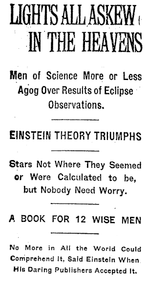Predictive power
- This article deals with predictive power in the context of the philosophy of science. For a statistical measure of predictive power, see mean squared prediction error.

The concept of predictive power differs from explanatory and descriptive power (where phenomena that are already known are retrospectively explained or described by a given theory) in that it allows a prospective test of theoretical understanding.
Examples
A classic example of the predictive power of a theory is the discovery of Neptune as a result of predictions made by mathematicians John Couch Adams and Urbain Le Verrier, based on Newton's theory of gravity.
Other examples of predictive power of theories or models include Dmitri Mendeleev's use of his periodic table to predict previously undiscovered chemical elements and their properties (though largely correct, he misjudged the relative atomic masses of tellurium and iodine), and Charles Darwin's use of his knowledge of evolution by natural selection to predict that because there existed a plant (Angraecum) with a long spur in its flowers, a complementary animal with a 30 cm proboscis must also exist to feed on and pollinate it (twenty years after his death Xanthopan morgani, a form of hawk moth, was found which did just that).
Another example of predictive power is the prediction of Einstein's general theory of relativity that the path of light would bend in the presence of a strong gravitational field. This was experimentally verified by an expedition to Sobral in Brazil and the Atlantic island of Príncipe to measure star positions during the solar eclipse of May 29, 1919, when observations made by the astrophysicist Arthur Eddington seemed to confirm Einstein's predictions.[1] Although the measurements have been criticized by some as utilizing flawed methodology,[2] modern reanalysis of the data[3][4] suggests that Eddington's analysis of the data was accurate. Later, more precise measurements taken by radio interferometry confirmed the predictions to a high degree of accuracy.
Applications
The predictive power of a theory is closely related to applications.
General relativity not only predicts the bending of light, but also predicts several other phenomena. Recently, the calculation of proper time of satellites has been a successfully-measured prediction, now incorporated into the method used to calculate positions via GPS.
If a theory has no predictive power, it cannot be used for applications.
References
- ↑ F. W. Dyson, A. S. Eddington, and C. Davidson, "A Determination of the Deflection of Light by the Sun's Gravitational Field, from Observations Made at the Total Eclipse of May 29, 1919," Philosophical Transactions of the Royal Society of London. Series A, Volume 220 (1920) pp. 291-333 (available online from the Royal Society)
- ↑ Harry Collins and Trevor Pinch, The Golem: What Everyone Should Know About Science, Cambridge University Press, 1993. (ISBN 0521477360)
- ↑ Daniel Kennefick, "Not Only Because of Theory: Dyson, Eddington and the Competing Myths of the 1919 Eclipse Expedition," Proceedings of the 7th Conference on the History of General Relativity, Tenerife, 2005; available online from ArXiv
- ↑ Phillip Ball, "Arthur Eddington Was Innocent," Nature, 7 September 2007, doi:10.1038/news070903-20 (available online 2007)